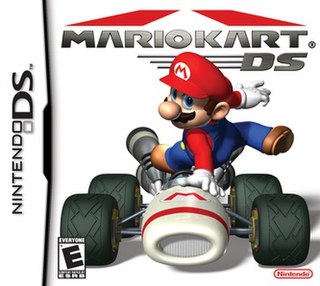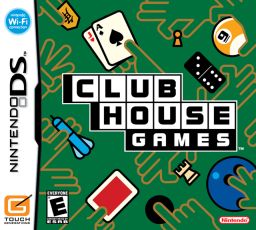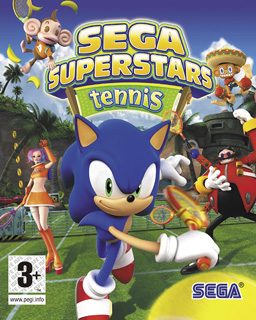Mario Kart is a series of kart racing games and a spin-off Mario franchise developed and published by Nintendo. Players compete in go-kart races while using various power-up items. It features characters and courses mostly from the Mario series as well as other gaming franchises such as The Legend of Zelda, Animal Crossing, F-Zero, and Splatoon.

Super Mario Kart is a kart racing game developed and published by Nintendo for the Super Nintendo Entertainment System (SNES). The first game in the Mario Kart series, it was released in Japan and North America in 1992, and in Europe the following year in 1993. Selling 8.76 million copies worldwide, the game went on to become the fourth best-selling SNES game of all time. Super Mario Kart was re-released on the Wii's Virtual Console in 2009, on the Wii U's Virtual Console in 2013, and on the New Nintendo 3DS's Virtual Console in 2016. Nintendo re-released Super Mario Kart in 2017 as part of the company's Super NES Classic Edition.

Mario Kart: Super Circuit is a 2001 kart racing game for the Game Boy Advance (GBA). It is the third Mario Kart game and retains its predecessors' gameplay: as a Mario franchise character, the player races opponents around tracks based on locales from the Super Mario platform games. Tracks contain obstacles and power-ups that respectively hamper and aid the player's progress. Super Circuit includes various single-player and multiplayer game modes, including a Grand Prix racing mode and a last man standing battle mode.

Tetris Attack, also known as Panel de Pon in Japan, is a puzzle video game developed by Intelligent Systems and published by Nintendo for the Super Nintendo Entertainment System. A Game Boy version was released a year later. In the game, the player must arrange matching colored blocks in vertical or horizontal rows to clear them. The blocks steadily rise towards the top of the playfield, with new blocks being added at the bottom. Several gameplay modes are present, including a time attack and multiplayer mode.

Wrecking Crew is an action game developed and published by Nintendo. Designed by Yoshio Sakamoto, it was first released as an arcade video game for the Nintendo VS. System in 1984, titled Vs. Wrecking Crew with a simultaneous two-player mode. It was released as a single-player game for the Family Computer (Famicom) console in 1985, and as a launch game for the Nintendo Entertainment System (NES) later that year. A sequel, Wrecking Crew '98, was released in Japan in 1998 for the Super Famicom.

Super Mario 64 DS is a 2004 platform game developed and published by Nintendo for the Nintendo DS. It was a launch game for the DS. Super Mario 64 DS is a remake of the 1996 Nintendo 64 game Super Mario 64, with new graphics, characters, collectibles, a multiplayer mode, and several extra minigames. As with the original, the plot centers on rescuing Princess Peach from Bowser. Unlike the original, Yoshi is the first playable character, with Mario, Luigi, and Wario being unlockable characters in early phases of the game.

Mario Kart DS is a 2005 kart racing video game developed by Nintendo EAD Group No. 1 and published by Nintendo. It was released for the Nintendo DS handheld game console in November 2005 in North America, Europe, and Australia, and on December 8, 2005, in Japan. The game was re-released for the Wii U's Virtual Console in North America and PAL regions in April 2015 and in Japan in May 2016.

Mario Party Advance is a party video game developed by Hudson Soft and published by Nintendo for the Game Boy Advance. Released in 2005, it is the first handheld game in the Mario Party series, and differs from other titles in that the game is mostly single-player. Mario Party Advance was followed by Mario Party DS for the Nintendo DS in 2007, and was re-released on the Wii U Virtual Console in 2014.

Yoshi Touch & Go, known in Japan as Catch! Touch! Yoshi!, is a video game that was developed and published by Nintendo for the Nintendo DS. It debuted in Japan on January 27, 2005, in North America on March 14, 2005, in Europe on May 6, 2005, and in Australia on May 19, 2005. As of August 2007, the game sold 197,337 copies in Japan. Yoshi Touch & Go was produced by Takashi Tezuka and directed by Hiroyuki Kimura. The game was released on the Wii U Virtual Console in 2015.

Daigasso! Band Brothers is a music video game published and developed by Nintendo for the Nintendo DS handheld game console. It was released in Japan on December 2, 2004 as a launch game for the Nintendo DS. The game features multiple songs, which include classical music, television themes, and video game music. The game is controlled using both the buttons on the DS as well as its touch screen in certain portions. It uses a variety of different instruments, which are combined selectively in order to compose a song. Besides the primary mode, players may play together, each one playing a different instrument in the song. Players may also compose their own songs. It was to be released in the United States as Jam with the Band, but was never released nor formally cancelled. It has a sequel titled Jam with the Band, which was released in Japan in 2008 and in Europe in 2010.

DK: King of Swing is a 2005 puzzle-platform game developed by Paon and published by Nintendo for the Game Boy Advance. King of Swing diverges from the gameplay of other games in the Donkey Kong series, instead featuring characters rotating around pegs to progress similar to the NES game Clu Clu Land. King of Swing has a single-player adventure mode, as well as a competitive multiplayer mode for up to four players. The game received mixed reception.

Mario Hoops 3-on-3, known in Europe as Mario Slam Basketball and in Japan as Mario Basket 3on3, is a sports game developed by Square Enix and published by Nintendo for the Nintendo DS in 2006. The game is the first in which Mario and Final Fantasy characters appear together as playable characters, and the second Mario game developed by Square Enix, the first one being Super Mario RPG. It is the first Mario basketball game ever to be released, although characters from the series have appeared in the GameCube version of NBA Street V3. The game was released on the European Wii U Virtual Console on May 26, 2016 and it was released on North American Wii U Virtual Console on November 3, 2016.
Game & Watch games have had many different re-releases.

Tetris DS is a puzzle video game developed and published by Nintendo. It was released for the Nintendo DS on March 20, 2006, in North America, April 13, 2006, in Australia, April 21, 2006, in Europe, and April 27, 2006, in Japan. An installment of the Tetris franchise, the game supports up to ten players locally, and supported online multiplayer of up to four players using Nintendo Wi-Fi Connection prior to its discontinuation.

Clubhouse Games, known in some European countries as 42 All-Time Classics and in Japanese as Dare demo Asobi Taizen, is a compilation video game developed by Agenda and published by Nintendo for the Nintendo DS, consisting of board, card, and tabletop games from around the world. It was released in Japan on November 3, 2005, in Europe on September 29, 2006, in North America on October 9, 2006, and in Australia on October 26, 2006.

Mario Strikers Charged is a 2007 sports video game developed by Canadian developer Next Level Games and published by Nintendo for the Wii. It is a sequel to Super Mario Strikers for the GameCube. It was released on May 25, 2007 in Europe, June 7, 2007 in Australia, July 30, 2007 in North America, September 20, 2007 in Japan, and March 18, 2010 in Korea.

Planet Puzzle League, known as Puzzle League DS in Europe, and as Panel de Pon DS in Japan, is a video game for the Nintendo DS handheld video game console in the Puzzle League Panel de Pon visual matching puzzle game series. In North America, Planet Puzzle League is part of the Touch! Generations brand; in Japan, Panel de Pon DS is marketed in the general Touch! brand. The publisher for the game is Nintendo, and the developer is Nintendo's second-party developer Intelligent Systems, creator of the original Panel de Pon and its cult classic English-language adaptation Tetris Attack. The game was released in Japan on April 26, 2007 in North America on June 4, 2007, and in Europe on June 29, 2007.

Mario Kart Wii is a kart racing game developed and published by Nintendo for the Wii. It is the sixth installment in the Mario Kart series, and was released in April 2008. Like its previous installments, Mario Kart Wii incorporates playable characters from the Mario series, who participate in races on 32 different race tracks using specialized items to hinder opponents or gain advantages. The game features multiple single-player and multiplayer game modes including two to four person split screen. Online multiplayer was supported until the discontinuation of Nintendo Wi-Fi Connection in May 2014. Mario Kart Wii uses the Wii Remote's motion-controls to provide intuitive and conventional steering controls. Each copy of the game was bundled with the Wii Wheel accessory to augment this feature and mimic a steering wheel.

Sega Superstars Tennis is a sports video game developed by Sumo Digital and published by Sega. It is the second title in the Sega All-Stars series, preceded by Sega Superstars (2005), and crosses over characters, locations, and soundtracks from several Sega franchises, including Sonic the Hedgehog, Space Channel 5, and Super Monkey Ball.

Yakuman (役満) is a 1989 mahjong video game developed by Intelligent Systems and published by Nintendo for its handheld Game Boy as one of the Japanese launch titles. It is the first entry in a series of first-party Japanese mahjong games on Nintendo systems, with sequels on the Famicom, Game Boy Advance, DS, Wii, Wii U, and 3DS.


















